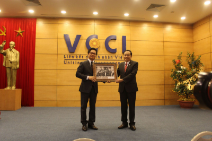Revising corporate income tax incentives to respond to global minimum tax
The amendment of corporate income tax (CIT) incentives helps Vietnam proactively develop solutions to cope with the application of Pillar 2 of the global minimum tax by countries around the world to maintain the attractiveness of the domestic investment environment and limit the application of preferential policies that are not effective.
 |
|
CIT incentives are an important tool in encouraging enterprises to invest in production and business. Illustrative photo: H.Anh |
In the draft document proposing to develop the Law on Corporate Income Tax (revised), the Ministry of Finance proposed to review tax incentives accordingly to contribute to a change in resource allocation, expanding the tax base, focusing on encouraging the production of high value-added products and high-technology products, encouraging innovation, socialization, environmental protection, related to agriculture, farmers, rural areas and investment in regions with difficult and especially difficult socio-economic conditions.
At the same time, the draft adds the principle of applying tax incentives to enterprises subject to the global minimum tax (Pillar 2) and the principle of paying additional tax difference for Vietnamese enterprises investing abroad which are subject to the global minimum tax to ensure Vietnam's taxing rights when participating in Pillar 2.
According to the Ministry of Finance, the current CIT Law stipulating CIT incentives (including tax rates, duration of tax exemption and reduction) in Chapter III of the Law, including six Articles (from Articles 13 to 18). The actual development shows that CIT incentives are an essential tool in encouraging enterprises to invest in production and business and attract FDI inflows. The adjustments and supplements to tax incentives along with reforms, promoting the business environment and creating favorable conditions for businesses, have made an important contribution to enhancing the attractiveness of the investment environment in Vietnam. However, the actual implementation of the current CIT incentive policy has also revealed weaknesses and limit ations that need to be reviewed and revised accordingly.
Regarding the application of tax incentives on an international scale, to solve tax challenges, the Global Cooperation Forum on Tax base erosion and profit shifting (BEPS) more than 140 countries have agreed and issued a statement on the implementation of the Two-Pillar Solution Framework for countries to study and implement in their countries, of which Pillar 2 is aimed at setting global standards for minimum corporate income tax, which has issued a mechanism that allows the country where the MNC's last parent company is located to have annual revenue In the Consolidated Financial Statements of the Supreme Parent Company of EUR 750 million or more, an additional tax payment shall be conducted for the income that the multinational company earns from its business investment activities in other countries with the CIT rate of less than minimum level of 15%.
Although the mechanism of additional tax payment to overseas parent companies neither affects Vietnam's tax collection for subsidiaries under the current policy nor forces Vietnam to cut incentives granted to subsidiaries, therefore, there is no guarantee of investment incentives granted in Vietnam to member subsidiaries investing in Vietnam (the taxpayers are the different legal entities in different countries). However, the problem is maintaining the attractiveness of investment attraction policies because other countries also enhance preferential policies to attract investment. Accordingly, it is necessary to research and propose appropriate solutions in the coming process of amending and supplementing the Law on CIT in accordance with the implementation mechanism of Pillar 2, and harmonize the interests of investors.
To expand the tax base in line with international practices through the adjustment of tax incentives, in the draft proposal to develop the revised Law on CIT, the Ministry of Finance proposed two solutions.
Firstly, maintaining the current regulations on CIT incentives. According to the Ministry of Finance, this solution does not change the tax incentive policy, ensures the stability of the policy and does not raise costs related to the implementation, but it does not overcome any problems.
Secondly, reviewing to amend and supplement regulations related to CIT incentives, to overcome the above shortcomings. Specifically, reviewing and rearranging tax incentives appropriately, creating changes in resource allocation, expanding the tax base, and focusing on encouraging high value-added production. Besides, supplementing the principle of applying tax incentives to enterprises subject to the global minimum tax (pillar 2) and the principle of additional payment of the difference in tax for Vietnamese enterprises investing abroad subject to the global minimum tax to ensure Vietnam's taxing rights when participating in Pillar 2. In addition, amending and supplementing regulations on tax incentives for expanding investment; supplement the content of special investment incentives to ensure consistency with the provisions of the Investment Law and participation in Pillar 2.
According to the Ministry of Finance, this solution will create a change in resource allocation, expand the revenue base, encourage and attract selective investment to develop conditional areas; unify all branches, fields and geographical areas eligible for tax incentives prescribed in tax laws; ensure consistency and synchronization between tax laws and specialized laws; limit the tax base erosion due to the application of preferential CIT policies. The amendment of CIT incentives helps Vietnam to proactively develop solutions to cope with the application of Pillar 2 of global minimum tax by countries around the world to maintain the attractiveness of the domestic investment market, and limit the application of ineffective preferential policies.








